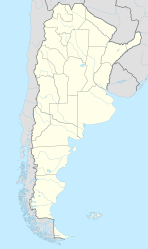Resistencia, Chaco
|
Resistencia Ciudad de Resistencia |
|
|---|---|
| City | |

(From top to bottom; from left to right) Panoramic view of the city; Chaco Government House; Palacio de Justicia of Resistencia; Resistencia Casino & Hotel and the New Bank of Chaco.
|
|
| Nickname(s): City of sculptures | |
| Location of Resistencia within Argentina | |
| Coordinates: 27°27′05″S 58°59′12″W / 27.45139°S 58.98667°WCoordinates: 27°27′05″S 58°59′12″W / 27.45139°S 58.98667°W | |
| Country | Argentina |
| Province | Chaco |
| Department | San Fernando |
| Government | |
| • Mayor | Aída Ayala (RCU) |
| Area | |
| • Total | 562 km2 (217 sq mi) |
| Elevation | 20 m (164 ft) |
| Population (2010) | |
| • Total | 291,720 |
| • Density | 520/km2 (1,300/sq mi) |
| Time zone | ART (UTC−3) |
| Area code(s) | 0362 |
| Climate | Cfa |
| Website | www |
Resistencia (pronounced: [resisˈtensja]) is the capital and largest city of the province of Chaco in north-eastern Argentina. According to the 2010 census, the population of the city proper was 291,720 inhabitants. It is the anchor of a larger metropolitan area, Greater Resistencia, which comprises three more municipalities for a total population of 387,340 as of 2010. This conurbation is the largest in the province, and the eleventh most populous in the country. It is located along the Negro River, a tributary of the much larger Paraná River, opposite the city of Corrientes, Corrientes Province.
The area was originally inhabited by Guaycuru aboriginals such as the Tobas. Their resistance to evangelisation postponed substantial European settlement until the late 19th century. Not until 1865 was a proper settlement established, and on January 27, 1878, Resistencia was formally established as the territorial capital. The national government supported immigration, and in 1878 the first Italian immigrants arrived. The first City Council was made up entirely of members originating from that country.
Resistencia is one of the warmest cities in Argentina, and is known for its extremely hot, humid summer weather with frequent lightning. The climate is humid subtropical (Köppen climate classification Cfa), with a cooler, dryer season and a long, humid summer. Fall and spring are often marked by sudden transitions from summer weather patterns to winter weather patterns.
...
Wikipedia

